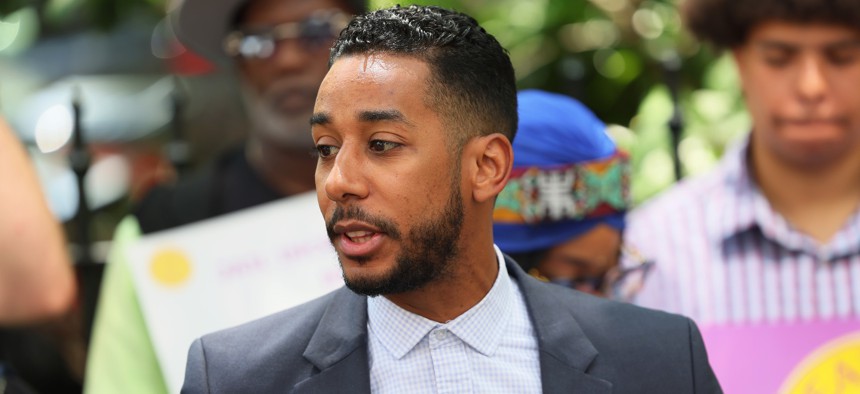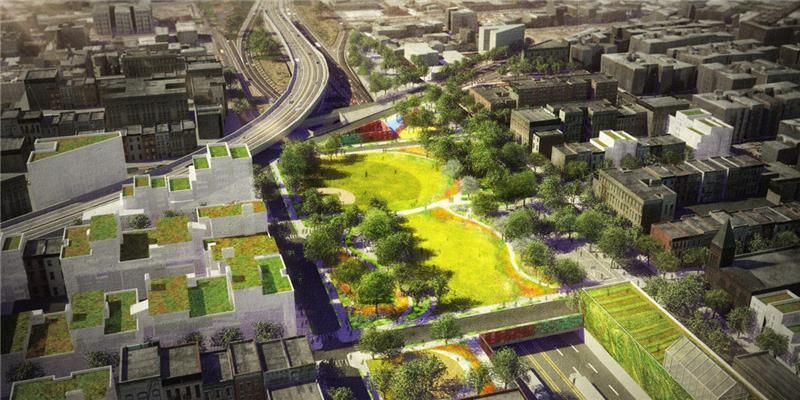Opinion
Opinion: Why won't Albany support building green space on the BQE?
Williamsburg could get 3.5 acres of green space – but only if New York state finally stands up against the racist legacy of the Brooklyn-Queens Expressway.

Brooklyn Borough President Antonio Reynoso speaks during a press conference at City Hall on June 1, 2023. Michael M. Santiago/Getty Images
Driving down the Brooklyn-Queens Expressway (BQE), it’s hard not to peer over the edge at the Brooklyn communities that lay below. You might have the chance to peek through the windows of some old brownstones. You might pass by kids chasing each other around a playground. You might even see the ships docked at the Gowanus Canal. But from the other side, our side on the streets of Brooklyn – it’s quite a different sight. The BQE looms large over our borough, reminding us that racism is built into the bones of our city. For generations, this highway has torn through our neighborhoods, dividing our communities in two, filling our air with toxic pollution and leaving behind a patchwork of dangerous pedestrian crossings.
The BQE was never built for the people who call this borough home, and from Greenpoint to Brooklyn Heights to Bay Ridge, we’ve spent decades begging for the city and state to do something, anything, to end the harm. Now, our mayor is on board and once-in-a-generation federal funding is within reach. All that’s missing is the support of our state government, and for no reason other than lack of will, they’ve outright refused. They’ve chosen to regurgitate the ills of the past and relegate Brooklyn to more of the same. Black and brown neighborhoods will remain collateral damage to car culture, and New York state is the one to blame.
The story begins in the 1940s, when the infamous city planner Robert Moses put forward a plan to bulldoze through working-class communities of color to build a highway that reached from Queens all the way to the southern edge of Brooklyn. For the most part, Moses got exactly what he asked for: communities like Greenpoint, Williamsburg, Sunset Park and Bay Ridge were severed in two; Red Hook was cut off from the rest of the borough entirely; and the BQE as we know it came to be.
Only one neighborhood, however, was spared the same degree of destruction. In Brooklyn Heights, where residents held more political power than their Black and brown neighbors to the north and south, Moses addressed outcry against the plan by building a triple cantilever into the retaining wall of a bluff along the waterfront. The bottom two levels of the cantilever allowed cars and trucks to skirt around the perimeter of the neighborhood instead of running through it, and the top level of the cantilever gave the community a public park and a promenade. While New York state owns the majority of the BQE’s 20 miles in Brooklyn, the city owns this 1.5-mile stretch in Brooklyn Heights called BQE Central where the cantilever is located.
The BQE’s legacy has been devastating for the neighborhoods that the state-owned portions of the BQE cut through. To this day, these communities remain split in two – pedestrians have to cross under dark, dirty underpasses or find the dangerous crosswalks that are few and far between to get from one side to the other. Big trucks chug through small residential streets. Children grow up playing on playgrounds covered in soot and breathing in toxic car emissions and pollutants that have been proven to contribute to and exacerbate asthma rates in our low-income communities.
But recently, the stars have all but aligned and an entirely reimagined BQE has become more possible than ever before. Weakened by road salt, moisture and overweight trucks, the triple cantilever is crumbling, and NYC DOT is moving quickly to redesign their stretch of the expressway before it collapses. To do so, the city is seeking to tap into over a trillion federal dollars set aside for infrastructure projects and answer US DOT’s call for applications for projects that reunite communities and address long-term environmental injustices.
The state, on the other hand, is refusing to do the same. Rather than match New York City’s commitment and take advantage of the funding now in arm’s reach, New York state has done nothing but dig in its heels and stonewall Brooklyn’s requests for the state to sign onto the city’s application for the federal dollars that would enable us to move forward on an entirely reimagined corridor.
But we won’t be collateral damage any longer. Last month, I was joined by Congresswoman Nydia Velázquez, fellow North Brooklyn elected officials and local community groups El Puente, Los Sures and St. Nick’s Alliance to renew our call for BQGreen, an over-a-decade-in-the-making plan to deck over a portion of the six-lane sunken highway that cuts through Williamsburg and top it with 3.5 acres of green space in our park-starved neighborhood.

The plan – first commissioned by then-Council Member Diana Reyna in 2010 – would platform over the BQE that runs below street level from South 5th to South 3rd street, connecting the Marcy Avenue parks with the Rodney Street parks. Almost out of thin air, Williamsburg would get a flower garden, playground, baseball diamond, barbecues, grassy and wooded areas, an indoor pool and more – not to mention the reduced air pollution, safer routes for kids to get to school and the jobs and customers that would fill our blocks.
Now, it’s over a decade later and we have the vision, we have the plan and we have the community support. All we need now is the state’s help. And I want to be clear: what we’re asking the state to do is not even the bare minimum – because the bare minimum would be co-applying with the city for the federal funding to reimagine the BQE in its entirety – from top to bottom. But we’ve tried that, and we’ve heard nothing but ‘no’ from the state. So now we’re asking for even less than that: for the state to at the very least apply to federal infrastructure funds like those in the Reconnecting Communities and Neighborhoods Grant Program for perfect-fit projects like BQGreen. BQGreen may be a small start, but it’s an essential one – and when we finally champion it through to reality, we will show the city, the state and this country that real urban renewal is possible wherever there is the will to seek it. But, if we miss this opportunity right now to address the harms of the past, to postpone justice for park-starved and polluted Williamsburg, make no mistake: New York state is to blame.
Antonio Reynoso is the Brooklyn borough president.
NEXT STORY: Commentary: Jamaal Bowman is Eric Adams' political nightmare

